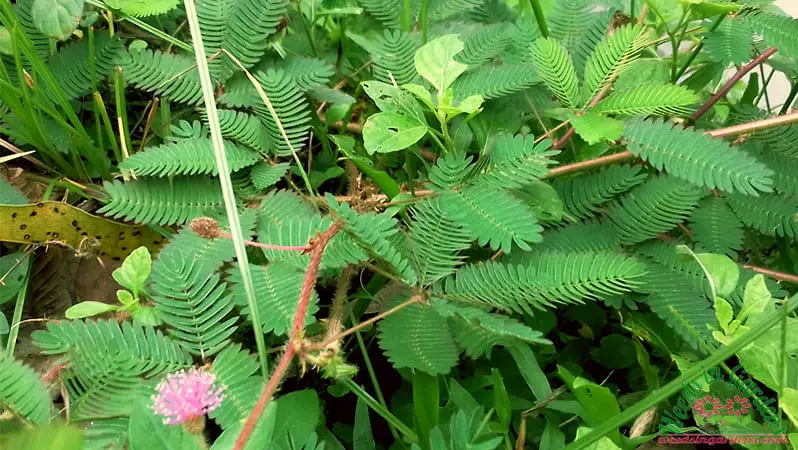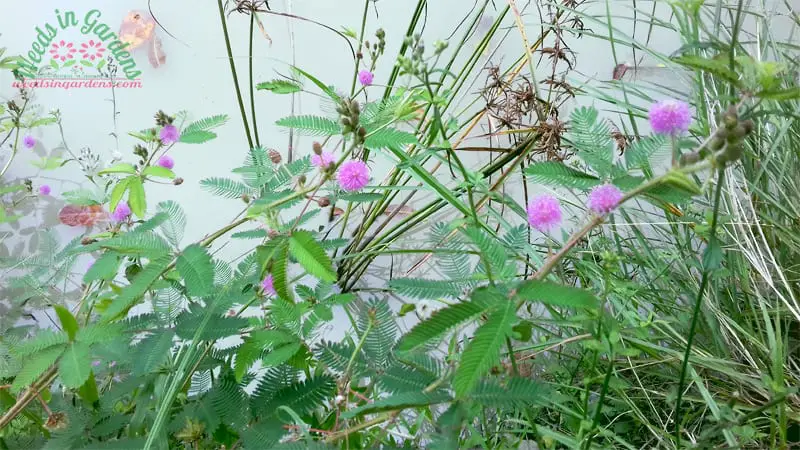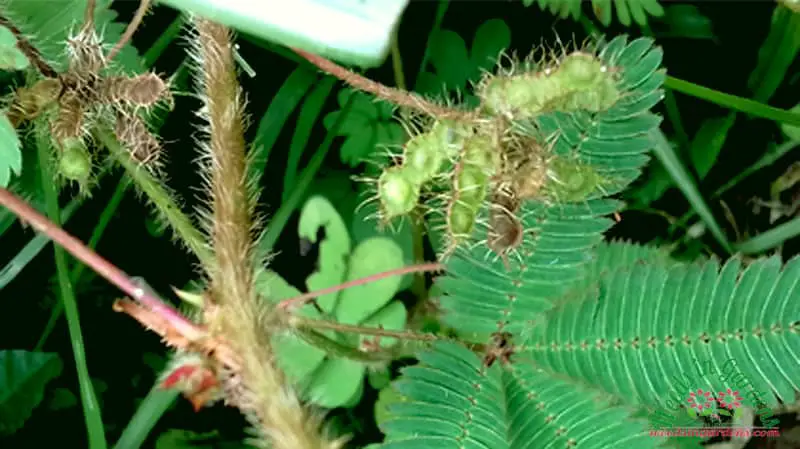When I was a university student, I often touched a plant to see its unusual leaf movements. We know it as “lojjaboti” which is globally known as “touch me not plant”. It grew naturally on the roadside of my university campus. Touch me not plant (Mimosa pudica) is a very sensitive plant that is sensitive to any touch or contact. This plant closes its compound leaves when someone or something touches it. It is so touch-sensitive that a small droplet of water on its leaves stimulates them to shut down.

For this shyness, touch me not plant or Mimosa pudica is also called shame plant, sensitive plant or lojjaboti/lajjabati. It is also known as makahiya. The shyness of this plant may be a defensive reaction. Shame plant or touch me not plant also shows shyness at night. Interestingly, makahiya is sensitive to light also. Its leaves close at night and open in the daylight. This interesting plant has some traditional medicinal uses. I want to tell you about its uses including medicinal benefits and the growing guide.
- Growing regions of touch me not plant
- Characteristics of touch me not plant
- Leaves
- Stems
- Flowers
- Fruits
- Seeds
- Roots
- Optimum temperature and humidity
- Soil pH for shame plant
- Reproduction
- Medicinal uses of touch me not plant
- Side effects of touch me not plant
- Other Benefits and uses of touch me not plant
- Mimosa pudica growing and care guide
- Touch me not weed control guide
- Scientific classification of touch me not plant/shame plant/makahiya
- Some common and local names used for Mimosa pudica
The scientific name or botanical name of touch me not plant is Mimosa pudica. Usually, it is considered an invasive weed. But some gardeners find Mimosa pudica as a very interesting plant to grow and take care of in their garden. Touch me not plants can also be used as good decorative and ornamental plants in your garden.
Growing regions of touch me not plant
Touch me not plant or shame plant is usually considered as a native plant of central and south America. But it is a common invasive plant in many tropical and subtropical countries including India and Bangladesh. You can find makahiya or shame plants on waste areas, forests, near cultivated lands, parks, gardens, roadsides and other undisturbed lands of many tropical and subtropical countries.
Characteristics of touch me not plant
Shame plant or touch me not plant is a perennial shrub. The height of the plant can be up to about a foot. You will like the pink globular blossoms of touch me not plant. Seismonastic movement is an interesting characteristic of Mimosa pudica.
Touch me not plant or shame plant uses special cells at the base of its leaflets and leaf stalks for seismonastic movement. When anything touches the leaves, the cells use to release water very fast and thus the leaves close. Then, when do the leaves of shame plant open again? After a few minutes, shame plant leaves come to a normal state.
If any animal comes to eat touch me not plants and touch them, the leaves and leafstalks start to move. This unusual movement makes the animals frightened, and they go away from the touch me not plant. Shame plants also have spines in their stems which are also used for defensive mechanisms. These special characteristics make this plant unique.
Leaves
Leaves and leaflets are mainly the touch-sensitive parts of touch me not or shame plant. The leaflets are placed at the ends of each petiole and measure between 3-10 cm in length. The leaflets are narrowly oval, non-equilateral, 1-1/4 cm long, with sharp tips. Leaflets of shame plant have no petioles (sessile). Tiny bristle-like hairs are present all over the leaves of touch me not plant. Cells of the downside of the pulvinus (the thick part that joints leaves/leaflets with stems) are responsible for the sensitiveness of Mimosa pudica.
Stems
Touch me not plant or shame plant have semi-woody stems. You will find tiny bristle-type hairs all over the stems. If you try to pull this plant with a bare hand, you may hurt yourself by prickles of its stems.
Flowers

You will find pink flowers, the blooming racemes on the plant. The globular blossoms are very nice that grow at the nodes of the branches. Touch me not plant is a cross-pollinated plant, and pollination occurs both by insects and wind.
Fruits
If you find a touch me not plant, you will notice clusters of pods with small spines at the margins. The length of the pods is around 1-2 cm. Each pod usually has 2-4 segments, each containing a single seed.

Seeds
Seeds of makahiya, shame plants or touch me not plants are compressed globular and brown in color. The seed length is about 0.25cm. Seeds of shame plant can remain viable even after 20 years.
Roots
Roots of touch me not plant go deep in the soil. So, it can withstand drought conditions. Because of its strong woody root system, this invasive plant is very hard to remove. The roots of the shame plant have secondary and tertiary branches. They are cylindrical and grey in color.
Optimum temperature and humidity
Touch Me Not Plant or shame plant likes high temperature and relative humidity. This plant normally grows well in temperate and semi temperate regions. 25-33°C temperature is good for its optimum growth. Relative humidity of more than 60% is ideal for shame plants.
Soil pH for shame plant
Slightly acidic soil is good for makahiya or touch me not plant. You will find shame plant as an invasive weed in undisturbed places, including forest areas where the soil pH ranges from 4.8 to 6.5 and environmental temperature ranges from 25-33°C.
Reproduction
Touch me not plant mainly reproduces through seed. A single makahiya plant can produce more than 200,000 seeds a year. Seeds of Mimosa pudica can be spread through wind or flood water. Seeds are also spread by animals and by human clothing. Shame plant is a fast-growing plant and produces seeds after 6-12 months of germination.
Medicinal uses of touch me not plant
Touch me not plant has been used by the common people in some regions. This plant contains valuable alkaloids and flavonoids with medicinal properties in its roots, shoots and leaves. Some people in southeast Asia especially in India and Bangladesh, use touch me not plant as a medicinal plant. Some traditional medicinal uses are listed here-
- Touch me not plant has a traditional use in the therapy of migraine, insomnia, looseness of the bowels, dysentery, fever etc.
- This sensitive plant has antioxidant properties.
- Some people believe that the shame plant has antitoxin properties.
- Some rural people in southeast Asia traditionally used this for birth control.
- Leaves of touch me not plant are used by some rural people for sinus problems. They use leaf paste for the remedy.
- It is heard that some tribal people use the roots of Mimosa pudica as a remedy for urinary problems.
- Makahiya plant is also believed to have anti-diabetic and antihepatotoxic activities.
- Some rural people also use makahiya plant for its anti-inflammatory and wound healing properties.
Side effects of touch me not plant
Just a few medicinal research studies have actually been reported on touch me not plant. So, you must avoid planning to use this plant as medicine by yourself.
Do you know?
- There are many look-alike poisonous plants that may cause a severe health hazards or even death. Touch me not or shame plant also have some look-alike plants.
- This plant may have some toxicity for you. Its toxicity or allergic effect on human body needs to be studied more by scientists.
- Due to environmental conditions, any nontoxic plant species may turn into a toxic one.
- Harmful fungi, bacteria or viruses may be attached on the surface of touch me not plant or makahiya that may cause health hazards after consumption.
So, please consult with experts if you want to use touch me not plant/ shame plant (Mimosa pudica) or any other plant for medicinal benefit.
Other Benefits and uses of touch me not plant
Touch me not plant can provide benefits as a stress-relevant plant as well as a medicinal plant. But more scientific research is needed for confirming its medicinal values and safe use. Touch me not plants are of great help during times of illness, both physical and mental, whether it’s you or someone close to you.
- Touch me not plant or shame plant can be used as an ornamental plant for a garden: Touch Me Not plants add beauty to your garden. You can grow them in your garden as an ornamental plant for their pink flowers or unusual leaves movement. Touch me not plants are evergreen shrubs that do not produce edible fruits or any other products.
- Mimosa pudica can be used to control unwanted pests: Touch me not plant controls pests of other plants by its extreme sensitivity to touch and movement. This unusual movement of shame plant or makahiya scares most insects away from them, including aphids and ants etc.
- Touch me not attracts beneficial insects to your gardens such as ladybugs and lacewing etc. These insects will help to control other unwanted pests. Ladybugs are effective natural enemies of many plant-eating bugs like aphids, whiteflies etc. Touch me not plants can be used in garden borders, flower beds and vegetable gardens to prevent aphids, whitefly etc. from destroying your plants.
- Touch me not plant has a highly effective use for lowering depression and anxiety, which is one of the most common problems in teens and adults worldwide. Touch me not plant can be used in the office environment where high-stress levels are a concern for employees.
- Touch me not plant can also be used in schools where high-stress levels and depression are a concern for teachers or students. Touch me not is excellent for lowering stress levels and lowering overall anxiety behaviour in teens, including school-going children. They feel less depressed due to the touch-sensitive nature of the shame plant and its leaves’ movement, which gives freshness to them.
- Mimosa pudica is also good for home and can be used as an indoor plant. But be sure to keep it in a safe place to avoid the shame plant’s thorns.
- Touch Me Not Plant can also be used for lowering stress levels in pets such as dogs, cats etc.
Mimosa pudica growing and care guide
Touch my not plant is commonly used in home gardens for ornamental flowers and touch-sensitive movements. Growing this plant is quite easy.
- Touch me not plant requires well-drained, moist soil with sufficient organic content. Use sandy loam soil for the best result.
- You already know that touch me not is a tough plant and can tolerate drought conditions because of its deep root. But when you want to grow it in a small pot then you have to ensure proper moisture in the soil. So, use loamy soil with proper drainage. You can use seed or stem cuttings to grow touch me not plant.
- Soak shame plant seeds for a couple of hours before planting.
- Touch me not plant wants sunshine with relatively high temperature and relative humidity. So, in the case of indoor planting, place this plant near a window so that it gets minimum lights for its survival and growth.
- Overwatering will make it difficult for your shame plant to survive. So, be careful about that.
- To maintain proper size and shape, you have to prone your shame plant. Cut the week or diseased part when necessary. Use sharp tools for pruning.
- This hardy plant needs a very little amount of fertilizer. If you use a good mixture of soil during planting shame plant, you don’t have to use fertilizer for at least 1-2 years. But if you find any symptoms related to nutrient deficiency, only then use a small amount of specific fertilizer as required.
To know more about touch me not plant propagation and care guide click here.
Touch me not weed control guide
Though loved by some gardeners, touch me not plant is mainly considered an invasive weed worldwide. Once established, this hardy plant is very difficult to control.
- If there are a few plants, you can remove this plant manually. But you should use protective gloves because there are prickles on its stems.
- Be careful about avoiding dropping fruits or seeds on the soil to ensure stopping its way to come back again.
- To deal with larger infestations of touch me not plant, chemical control measures may be required. Read the instructions on the herbicide pack carefully before using herbicides.
Scientific classification of touch me not plant/shame plant/makahiya
| Kingdom | Plantae |
| Division | Magnoliophyta |
| Class | Magnoliopsida |
| Order | Fabales |
| Family | Fabaceae |
| Subfamily | Mimosoideae |
| Genus | Mimosa |
| Species | Mimosa pudica |
Some common and local names used for Mimosa pudica
Ajalikalika
Bashful mimosa
Bashful plant
Betguen sosa
Bunga semalu
Chuimui
Damohia
Dilgansusu
Hadergitte
Hti ka yoan
Humble plant
Kasirottam
Lajak
Lajjalu
Limemeihr
Lojjaboti/Lajjabati
Lajavanti/Lajawanti
Makahiya
Manugumaramu
Mateloi
Mechiuaiu
Memege
Mori vivi
Najuk
Pokok semalu
Putri malu
Semalu
Ra kau pikikaa
Sensitive plant
Shame plant
Shyness grass
Shrinking plant
Sleeping grass
Sleepy plant
Touch-shy plant
Tickle-Me plant
Tuyag-huyag
Varakranta
Vashini etc.
